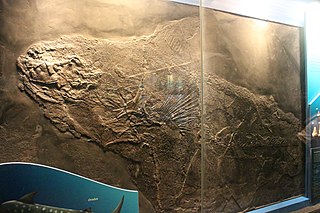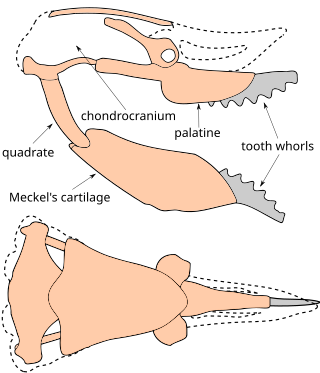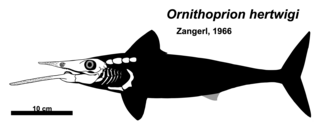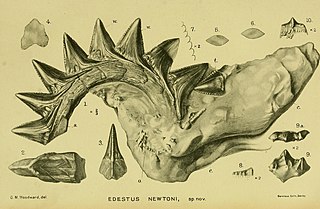
Chondrichthyes is a class of jawed fish that contains the cartilaginous fish or chondrichthyans, which all have skeletons primarily composed of cartilage. They can be contrasted with the Osteichthyes or bony fish, which have skeletons primarily composed of bone tissue. Chondrichthyes are aquatic vertebrates with paired fins, paired nares, placoid scales, conus arteriosus in the heart, and a lack of opercula and swim bladders. Within the infraphylum Gnathostomata, cartilaginous fishes are distinct from all other jawed vertebrates.

Helicoprion is an extinct genus of shark-like eugeneodont fish. Almost all fossil specimens are of spirally arranged clusters of the individuals' teeth, called "tooth whorls", which in life were embedded in the lower jaw. As with most extinct cartilaginous fish, the skeleton is mostly unknown. Fossils of Helicoprion are known from a 20 million year timespan during the Permian period from the Artinskian stage of the Cisuralian to the Roadian stage of the Guadalupian. The closest living relatives of Helicoprion are the chimaeras, though their relationship is very distant. The unusual tooth arrangement is thought to have been an adaption for feeding on soft bodied prey, and may have functioned as a deshelling mechanism for hard bodied cephalopods such as nautiloids and ammonoids. In 2013, systematic revision of Helicoprion via morphometric analysis of the tooth whorls found only H. davisii, H. bessonowi and H. ergassaminon to be valid, with some of the larger tooth whorls being outliers.

Edestus is an extinct genus of eugeneodontid holocephalian fish known from the Late Carboniferous (Pennsylvanian) of the United Kingdom, Russia, and the United States. Most remains consist of isolated curved blades or "whorls" that are studded with teeth, that in life were situated within the midline of the upper and lower jaws. Edestus is a Greek name derived from the word edeste, in reference to the aberrant quality and size of the species' teeth. The largest species, E. heinrichi, has been conservatively estimated to reach greater than 6.7 m (22 ft) in length, around the size of the largest known great white shark, possibly making it the largest marine predator to have ever existed up to that point.

Sarcoprion is an extinct genus of eugeneodont holocephalan from the Permian of Greenland. Similar to other helicoprionids such as Agassizodus and Helicoprion, it possessed tooth whorls on the symphysis of the jaw as well as flattened, pavement-type teeth. It is distinguished from other members of its family by the presence of sharp, symphyseal teeth on both the upper and lower jaws. The tooth whorl on the lower jaw bore sharp, compact tooth crowns, while a row of backward facing, triangular teeth was present on the roof of the mouth. The preserved material does not show evidence of a distinct upper jaw, implying it may have been fused to the cranium, reduced, or lost entirely. The type and only species in the genus is S. edax.

Orodus is an extinct genus of cartilaginous fish that lived from the late Pennsylvanian to the early Permian in what is now North America. O. greggi reached around 2–4 metres (6.6–13.1 ft) long, while O. micropterygius just reached 1 metre (3.3 ft). It was a member of the holocephali subclass, meaning that it was more closely related to chimaeras and their relatives, and not elasmobranchs like sharks and rays.

Campodus is an extinct genus of eugeneodont holocephalans from the Carboniferous. Likely one of the earliest and most basal caseodontoids, it can be characterized by its broad, ridge-ornamented crushing teeth made of various types of dentine. The type species, C. agassizianus, was originally described in 1844 based on a small number of teeth from the Namurian of Belgium.

Fadenia is an extinct genus of eugeneodontid holocephalian chondrichthyan from the Carboniferous Period of Missouri, the Permian period of Greenland, and the Early Triassic epoch of British Columbia, Canada.

Caseodus is an extinct genus of eugeneodontid holocephalian from the Carboniferous of the United States and the Early Triassic of Canada. It was of medium size, measuring 1–1.5 m (3.3–4.9 ft) in length.

Parahelicoprion is an extinct genus of shark-like cartilaginous fish that lived during the Early Permian. Two species are known ; P. clerci from Arta Beds of the Ural Mountains of Russia, and P. mariosuarezi from the Copacabana Formation of Bolivia. Members of the genus possessed a row of large tooth crowns on the midline of the lower jaw, known as a tooth whorl. The characteristics of this whorl are unique to fishes of the order Eugeneodontida, and more specifically the family Helicoprionidae to which Parahelicoprion belongs. The genus name refers to Helicoprion, another eugeneodont from the Ural Mountains that bore a similar midline tooth arrangement.

Helicoprionidae is an extinct family of holocephalans within the order Eugeneodontida. Members of the Helicoprionidae possessed a "whorl" of tooth crowns connected by a single root along the midline of the lower jaw. While historically considered elasmobranchs related sharks and rays, the closest living relatives of the Helicoprionidae and all other eugeneodonts are now thought to be the ratfishes. The anatomy of the tooth-whorls vary between taxa, with some possessing highly specialized, coiling spirals, while others such as Sarcoprion and Parahelicoprion possessed shorter whorls.

The Edestidae are a poorly known, extinct family of shark-like eugeneodontid holocephalid cartilaginous fish.
Watsonichthys is an extinct genus of ray-finned fish that lived during the Tournaisian age to possibly the Asselian age in what is now Europe and possibly Namibia. It is named after David Meredith Seares Watson.
Toxoprion is an extinct genus of eugeneodont holocephalans whose fossils are found in marine strata from the Early Carboniferous until the Late Permian near Eureka, Nevada.

Ornithoprion is a genus of extinct cartilaginous fish in the family Caseodontidae. The only species, O. hertwigi, lived during the Moscovian stage of the Pennsylvanian, between 315.2 to 307 million years ago, and is known from black shale deposits in what is now the Midwestern United States. The discovery and description of Ornithoprion, performed primarily via radiography, helped clarify the skull anatomy of eugeneodonts; a group which includes O. hertwigi and which were previously known primarily from isolated teeth. The genus name, which is derived from the ancient Greek órnith- meaning 'bird' and príōn meaning 'saw', was inspired by the animal's vaguely bird-like skull and the saw-like appearance of the lower teeth. The species name honors Oscar Hertwig.

Agassizodus is an extinct genus of eugeneodont holocephalian from the Carboniferous. It belongs to the family Helicoprionidae, which is sometimes called Agassizodontidae. Like other members of its family, it possessed a symphyseal tooth whorl, which was likely present at the tip of the lower jaw and associated with lateral crushing toothplates. The type species, A. variabilis, was originally named Lophodus variabilis until the name "Lophodus" was determined to be preoccupied.

Romerodus is an extinct genus of cartilaginous fish in the family Caseodontidae. While it and the rest of its family were historically considered elasmobranchs related to sharks and rays, they are now regarded as holocephalans, a diverse subclass which is today only represented by chimaeras. Romerodus is known from the Carboniferous and possibly Permian periods of North America, and the only named species, R. orodontus, was discovered in organic shale deposits in the U.S. state of Nebraska. It is one of few members of its order, the Eugeneodontida, that is known from multiple complete, well preserved body fossils, and is thus an important taxon for understanding the anatomy and ecology of less well preserved eugeneodonts such as Helicoprion. The genus name honors paleontologist Alfred Romer.

Lestrodus is an extinct genus of edestid fish that lived during the Late Carboniferous. It contains one valid species, L. newtoni, which is known from a single tooth whorl from the Millstone Grit of England. It was originally named as a species of Edestus, but is now considered a distinct genus based on morphological differences.

The Caseodontidae is an extinct family of eugeneodont holocephalans known from the late Paleozoic to earliest Mesozoic of Greenland, Canada and the United States. Members of the group are characterized by a reduced or absent palatoquadrate, elongate upper and mandibular rostra, and bulbous, crushing dentition, including a small symphyseal whorl of teeth on the lower jaw and batteries of teeth fused directly to the neurocranium. Several genera are known from partial or complete body fossils.
The Eugeneodontidae is an extinct family of eugeneodont holocephalans known from the late Paleozoic the United States and Iran. A defining trait of the group is pavement-like dentition with blade-like teeth, implying a divergent diet to the closely related caseodontids which they otherwise closely resemble. Both Eugeneodus and Gilliodus are known from virtually complete skeletons, including extensive patches of preserved dermal denticles. The name of both the family and the type genus, and by extension the entire order of Eugeneodontida, are in honor of Paleontologist Eugene S. Richardson Jr.

Paredestus is a monotypic genus of extinct eugeneodont holocephalan from the Early Triassic of Canada. The type and only species, P. bricircum represents the last known member of the superfamily Edestoidea and among the last known eugeneodonts. It was named in 2008 based on tooth and jaw material, with the holotype representing the only known specimen.






















